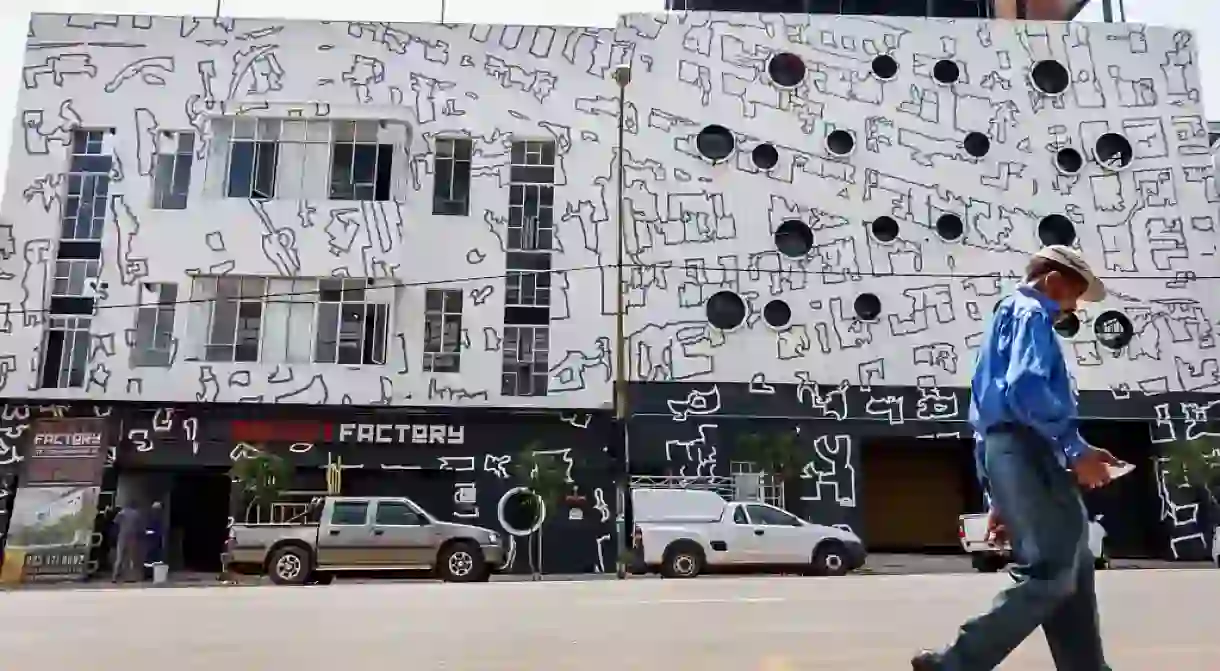Inside Maboneng, Johannesburg’s Answer to Shoreditch and Dumbo

Johannesburg’s Maboneng precinct, roughly 10 minutes from the city centre, is being touted as South Africa’s answer to London’s Shoreditch and New York’s Dumbo neighbourhoods. Journey to this gritty, colourful and increasingly popular part of town to see what all the fuss is about.
Maboneng sits alongside industrial warehouses reappropriated as gospel churches (the congregation conversing beside half-faded signs for panel beaters and mechanical repairs). This isn’t the Johannesburg you read about in books or the one often seen on television.
Instead, nights here are spent listening to live jazz, smoking cigars and eating sliders. Johannesburg has suffered more than most, but from the post-apartheid ashes an exciting, increasingly livable city has emerged. Maboneng’s 40-metre (131-foot) mural of Mandela stands as a striking modern symbol of the city’s development.

Success and failure
Bheki Dube founded Curiocity Backpackers, a design hostel on Fox Street, four years ago. Bheki, a “born, bred and buttered” Joburger, grew up skating and photographing Maboneng when the neighbourhood was still notorious. “There wasn’t any economy here when I was a kid,” says the poster boy for its regeneration. “Just abandoned buildings and nonfunctional warehouses.”
“No one would chill here 10 years ago,” he tells Culture Trip. Dube was one of the first commercial tenants in the area and part of the Global Shapers Community responsible for Maboneng’s transformation. He is friends with Jonathan Liebmann, a South African entrepreneur who helped put Maboneng on the map with the work of his land development company, Propertuity.
Maboneng’s transformation began eight years ago when Propertuity turned a block of abandoned warehouses into Arts on Main, leasing spaces to acclaimed South African artist William Kentridge and art entrepreneur David Krut. Today there are more than 600 commercial tenants, including galleries, restaurants and even an independent cinema. Liebmann’s dream was realised in the variety of successful businesses that still operate in the area, although his own company collapsed partly due to an underestimation of the task in hand.

If you want to experience more of Maboneng, try joining P.A.S.T Experiences for one of their inner city tours. Founder Jo Buitendach leads a guided art walk and highlights Johannesburg’s big Ethiopian community and the emergence of subcultures like graffiti and skateboarding.
The emergence of Maboneng
South Africa’s capital was ravaged by apartheid in the 20th century, the wounds of which have never really healed. Like Soweto (South West Township), Maboneng (which translates from Sotho as ‘place of lights’) is somewhere people come to communicate with the past through artistic expression.
In one section of the street you can see the rough work of young artists alongside multistorey murals made by more experienced hands. “Graffiti has found a space in Maboneng, especially on the pillars under the highway and in the surrounding Jeppestown area,” says Buitendach.
The sculpture garden at The Cosmopolitan, overlooked by an enormous mural of 17th-century Dutch colonialist Jan van Riebeeck by street artists Gaia and Freddy Sam, encapsulates the dramatic changes in this part of town. “The eastern edge of the city is covered in art, in many different forms,” says Buitendach. “But the graffiti subculture in Joburg’s city centre is strong, gritty and amazing.”

Another new landmark in the area is Hallmark House hotel, a black behemoth designed by Ghanaian-British architect Sir David Adjaye. It’s big, softly lit and luxurious, and sticks out from the skyline like a lump of coal against metal and glass. “Seeing this transformation says a lot about where Johannesburg has come from and what it is becoming,” Dube says from the rooftop of the hotel.
It’s a neighbourhood in the middle of rapid transformation, an African spring in the heart of Johannesburg. Who knows how long Maboneng will be able to keep its authenticity, but, for the time being, both residents and visitors are enjoying a new chapter in Joburg’s story.
Additional reporting by Cassam Looch













